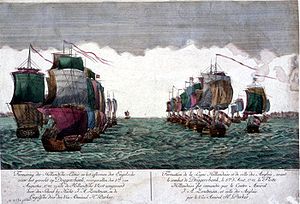Anglo-Dutch War (1780–1784)
| date | 1780 to 1784 |
|---|---|
| place | North Sea , Caribbean , India , Sumatra , Ceylon |
| Casus Belli | British attack on Dutch merchant ships |
| output | British victory |
| Territorial changes | The Dutch colony of Nagapattinam goes to Great Britain |
| consequences | Great Britain receives free trade in parts of Dutch India |
| Peace treaty | Peace of Paris 1784 |
The Fourth Anglo-Dutch War was a military conflict between the Kingdom of Great Britain and the United Provinces of the Netherlands from 1780 to 1784. It was the fourth in a series of Anglo-Dutch naval wars in the 17th and 18th centuries.

prehistory
The outbreak of the American War of Independence (1775–1783) led to expressions of sympathy for the efforts of the American settlers in the United Netherlands. The anti-British sentiment already existing in the republic, caused by the economic decline of the States General and the simultaneous rise of British naval power, increased at the same time and soon became noticeable in the economic support of the American colonies. Large quantities of arms and ammunition were sold to the colonists from the Dutch possessions in the West Indies , and particularly from St. Eustatius .
As early as February 1777, the British government sent a memorandum to the States General demanding the immediate cessation of these activities and the replacement of the Dutch governor of this island. Otherwise the Royal Navy would take action against it itself. The tone of the memorandum snubbed the Dutch public, who were already angry about numerous attacks by the British on Dutch merchant ships.
Although he was more pro-British himself, the governor Wilhelm V (1748–1806) had no choice but to prepare for war. In the autumn of 1779, a Dutch West Indies convoy was first shot at by British ships in the English Channel and pushed into the port of Plymouth . In the autumn of 1780, more ships were searched and documents were found which proved how close the American-Dutch trade relations were.
course
The open outbreak of war was now inevitable and took place in December 1780. At that time, however, the Dutch fleet was no longer a serious opponent for the Royal Navy. In addition, the Dutch Admiralty was ruled by the pro-British orangist party , which prevented a determined warfare. The British government therefore assumed that it would be easy to conquer the Dutch colonies and thus compensate for the already looming loss of the North American colonies.
In fact, the war turned out to be a disaster for the States General as early as the winter of 1781. In January alone, 200 Dutch merchant ships were seized. In February, Admiral George Rodney (1718–1792) captured the island of St. Eustatius. The only major but undecided meeting of the two fleets took place on August 5, 1781 in the battle of the Dogger Bank . In the months that followed, the Dutch avoided further battles. The British, however, conquered the West African possessions of the WIC , as well as some colonies of the VOC . The latter trading company alone lost 10 million guilders in shipping.
Only the intervention of the French navy (France had also been at war with England since 1779) secured the Dutch position. French warships recaptured most of the African and Far Eastern colonies. On September 2, 1783, at the Peace Congress in Paris, the first preliminary peace was concluded , but it was only months later, on May 30, 1784, that the Peace of Paris was concluded .
Individual evidence
- ↑ Jonathan Israel: The Dutch Republic - Its rise, greatness and fall 1477-1806 , Oxford 1995, p. 1096
- ^ A b c Jonathan Israel: The Dutch Republic - Its rise, greatness and fall 1477-1806 , Oxford 1995, p. 1097
literature
- Jaap Bruijn: Varend Verleden - De Nederlandse Oorlogsvloot in de 17e en 18e Eeuw. Meppel 1998, ISBN 90-5018-407-3 .
- Jonathan Israel: The Dutch Republic - Its rise, greatness and fall 1477-1806 , Clarendon Press, Oxford 1995. ISBN 0-19-873072-1
- Alexander Meurer: History of naval warfare in outline. Leipzig 1942,
- Helmut Pemsel : Command of the Sea. Vol. 2. Vienna / Garz 2005. (= Helmut Pemsel: Weltgeschichte der Seefahrt. Vol. 5. )
- Jan Willem Schulte Nordholt: The Dutch Republic and American Independence , University of North Carolina Press, Chapel Hill / London 1982. ISBN 0-8078-1530-6
